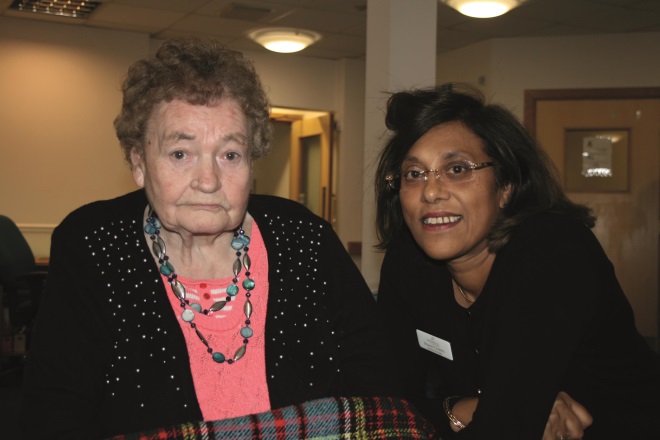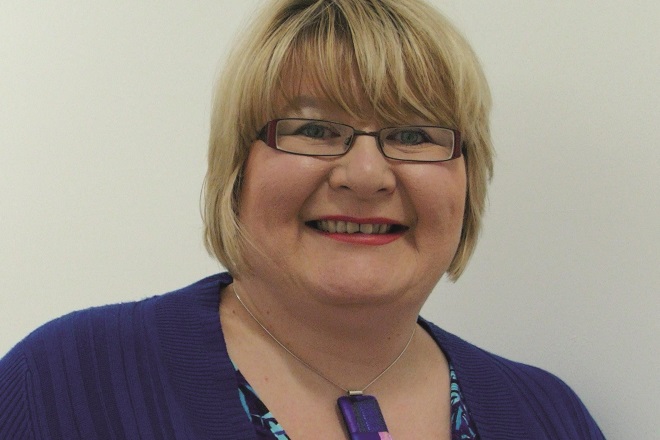
Matthew Hollings
A frail, older lady stooped over her Zimmer frame slowly edges across the long carpeted hallway of the Queens Court nursing home in Wimbledon, south London. A family friend follows closely behind, carrying a large box.

Source: Elizabeth Sukkar
Sharaan Caratella (right), general manager of Queens Court nursing home, with resident Audrey Palmer, says polypharmacy is still an issue in care homes
“Stop, if you don’t mind,” calls Sharaan Caratella, the sprightly general manager. “Have a look at this,” she says, pointing at the box.
Within it lie several large blister packs of medicines that detail the day and time they need to be taken, otherwise known as monitored dosage systems, and a dozen or so packets of open and unused medicines. “So many medicines,” says Caratella, shaking her head.
Polypharmacy — the use of multiple medicines — is still an issue at the 41-bed home, Caratella explains, where the average resident is 88 years old and usually on seven or more medicines.

Katy Jackson, head of prescribing at the Brighton and Hove clinical commissioning group, says its medication review service has led to a reduction in the pill burden for older residents
Sometimes it is many more than seven drugs. Take ‘Margaret’ who resides at another care home 85km away in Brighton, West Sussex. Margaret is 86 years old and was taking 25 different medicines. “No one had assessed her for years to see if she still needed to take them all,” says Katy Jackson, head of prescribing at the Brighton and Hove clinical commissioning group (CCG), which decides what services should be funded in the area. “She was drowsy, non-engaged and suffering side effects.”
After referring to Margaret’s GP medical records and following discussions with her, care home staff and her family, a pharmacist advised that some medicines were stopped. In the end, she was on only five drugs: two for pain relief, two for hypertension and one for her constipation .
“She is feeling a lot better,” says Jackson. “She is alert and has a better quality of life.” Across Great Britain, pharmacists funded by CCGs are undertaking medication reviews of care home residents, and deprescribing is an important part of their work. Pharmacists are also requesting better monitoring of patients, and adding drugs to their treatment regimen that will be beneficial. They are also looking at the administration and ordering of medicines in care homes to reduce mistakes and improve medicines optimisation.
There is little national data on what proportion of care homes review their residents’ medication or how often it happens in those that do. The National Institute for Health and Care Excellence (NICE) recommends that residents have a medication review at least once a year, something the Department of Health (DH) says it expects both public and privately-run care homes to follow.

David Alldred, associate professor of pharmacy practice at the University of Leeds, says any medication review should be multidisciplinary, involving the GP, pharmacist, resident and/or family member and care home staff
“Unfortunately, there is no national service for a medication review in care homes,” says David Alldred, associate professor of pharmacy practice at the school of healthcare at University of Leeds. “The intervention is done on a patchy basis and, as far as I’m aware, there are no data collected nationally.”
The NHS is responsible for many aspects of medication use in care homes, while care homes themselves have a legal duty to store and administer medicines properly, explains the DH.
A report published in October 2015 by the regulator of health and social care services, the Care Quality Commission (CQC), highlights the ongoing problems around poor medicines management in care homes. The ‘State of care’ report found that medicines were not administered properly — some residents had their medicines delayed while others showed symptoms of overdose.
Alldred helped develop the NICE guidelines, published in 2014. He was also an investigator in the ground-breaking DH-funded ‘Care Homes Use of Medicines’ (CHUMs) study, published in 2009[1]
, which analysed 256 care home residents and found that two thirds of them had been exposed to one or more medication errors, including prescribing, monitoring, administration and dispensing errors.
“[Following CHUMs,] I desperately wanted to do something to improve the care of care home residents in Brighton and Hove,” says Jackson, so she initiated a pharmacist-led medication review project, which is now in its fourth year. In 2013–2014, the service cost £100,000 per year to run but has already made annual savings of £260,000 from reduced drug costs and £330,000 from reduced hospital admissions.
But it isn’t only about savings. Jackson says the service has reduced medicine waste, prescription errors, polypharmacy and inappropriate medication. “It has introduced more deprescribing, safer prescribing and a reduction in pill burden for older residents,” she says. “Patients feel more alert, memory loss has improved significantly and there have been fewer falls in residents.”
In the north of the country, Leeds West CCG ran a similar project, which started as a pilot in 2011–2012 and became a fully funded service in August 2015 after its impressive results.
Between July 2013 and July 2015, the medication review team, which undertook reviews in 80 care homes, recommended 2,562 medicines-related changes to GPs, of which 93% were accepted.

Source: NHS Leeds West Clinical Commissioning Group
A care home medication review team led by Helen Whiteside, pharmacist at the Leeds West CCG, uncovered 200 medication incidents, some life threatening
“In this period, we saw around 700 residents and made around four medicines changes per resident,” says Helen Whiteside, medicines optimisation pharmacist and care home lead at the Leeds West CCG. She estimates that one third of CCGs are funding medication reviews in care homes.
The team also uncovered 200 medication incidents, some life threatening, such as digoxin toxicity and potential diabetic coma where a patient’s blood glucose levels had not been monitored.
Less is more
A new word is entering the healthcare lexicon — ‘deprescribing’. Coined in Australia in 2003, deprescribing has been defined as “medication withdrawal in the elderly”[2]
. A recently published systematic review described it as “the process of withdrawal of an inappropriate medication, supervised by a healthcare professional, with the goal of managing polypharmacy and improving outcomes”[3]
.
We aim to keep the most beneficial drugs and cut out the ones that are causing problems
“Most of our pharmacists’ work — around 70% of their time — is [spent] deprescribing drugs that may not be appropriate in an older person,” says Whiteside. “We always discuss this with the patient, carer and/or family member first. We aim to keep the most beneficial drugs and cut out the ones that are causing problems.”
Currently, there is a huge push for deprescribing in older people because of the known risks of polypharmacy, especially when combined with the changes in an older person’s body that can alter the effectiveness of medicines and increase side effects.
“If you look at the average number of medicines a care home resident is taking it’s around 9 or 10, with some on 20–25 medicines,” says Alldred. “The problem is that we have very little evidence that giving an older person… all of these drugs is beneficial. This is not about denying people appropriate treatment, but about improving their quality of life.” But prescribers find deprescribing a difficult subject to broach with residents and family members, says Whiteside, because it may look like essential treatment is being withdrawn. Some might consider the withdrawal of treatment ageist, she adds.
“Older people have a right to treatment, and if we came across a fit 85-year-old who would continue to benefit from a statin, we would not consider stopping it,” she says.
But most residents in nursing homes are frail and their long-term prognosis is not good because they have life-limiting diseases. “So in most cases, statins are halted and we focus on continuing more important symptom-control medicines.”
In the case of the Margaret in Brighton who was on 25 drugs, deprescribing raised important questions, such as which drug should be stopped first and why? “How would we stop it?” asks Jackson. “What explanation would we give the resident? These are the sorts of questions pharmacists need to ask themselves when faced with these cases.”
Alldred acknowledges that there are many different models for how medication reviews should be done in care homes. “We don’t currently know which is the best model,” he says. “However, any medication review should be multidisciplinary, involving the GP and pharmacist but, most importantly, the resident and/or family member and care home staff.”
Families are important and are often left out of the medication review process
But some reviews are done remotely without any involvement from the resident or their family. “That’s not good enough. Families are important and are often left out of the medication review process,” he says.
Some of the medicines pharmacists are stopping include anticholinergic drugs, opiates and antipsychotics (used for reducing the behavioural and psychological symptoms of dementia), because of the risk of side effects. They are also stopping drugs that can cause drowsiness, such as benzodiazepines and tricyclic antidepressants (used in pain management), as this increases the risk of delirium, and the chance of falls, which have a cost to the NHS in the long term.
Pharmacists also cut out drugs that can cause constipation as this can also increase the risk of delirium. Antihypertensive drugs are often deprescribed or doses reduced as they can lower the blood pressure too much, leading to a risk of falls.
A resident in a nursing home is often unlikely to live more than a year after admission, says Whiteside, so taking too many drugs that can cause nausea, vomiting and muscle aches and pains will affect his or her quality of their life.
Making the rounds
At the Queens Court nursing home in Wimbledon, Caratella explains that 70% of residents have dementia and the average life expectancy is around 18 months after admission.
Its drug storage room is a small closet-like space where the drug trolley and the medication administration record (MAR) sheets are kept. Each day there are three drug rounds: 8am, 1pm and 5pm. Rounds should take no longer than an hour as that is a “safe window”.

Source: Barchester Healthcare
Drug rounds can take a long time to complete properly, says Trish Morris Thompson, director of quality and clinical governance at care home provider Barchester Healthcare
But this window is hard to apply. Queens is part of Barchester Healthcare, an independent provider, with more than 200 care homes in the UK (see ‘Care home residents: private or publicly funded?’). Trish Morris Thompson, its director of quality and clinical governance, says there is a rising complexity in the medicines older people are taking, made worse by the fact that nurses are interrupted regularly during drug rounds.
“A drug round can take a long time to complete properly. For instance, it can take up to 3 hours for just 30 residents,” says Morris Thompson, who is also a senior nurse advisor to the care industry body Care England. “You have to sit with each resident, check they are sitting up, then they have to take each medicine with water.”
But Barchester is looking at ways to make drug rounds more efficient and safer for residents, so medicines are given according to their dosage regimen. In August 2015, it piloted an electronic medicines management system involving six homes and Boots and Lloyds pharmacies. “It has been a huge success,” Thompson says. “It has significantly cut the number of medication errors, we have seen better stock control, and there has been better timely administration of medicines for residents.”
The ‘3 hours per 30 resident’ drug round is predicted to be cut by 30–40 minutes, so nurses will have more time for direct resident care. Over the next two months, the pilot will inform a specification so Barchester can put the service out to tender across all of its care homes.

Source: CQC
Brian Brown, national medicines manager at the Care Quality Commission, says the regulator sees long medicine rounds in care homes
While Barchester is supporting innovation, poor leadership seems to be behind some medicines management-related problems seen in care homes, according to Brian Brown, national medicines manager at the regulator, the CQC.
“Prescriptions are not ordered on time so there is a gap in the supply chain, we see problems around the storage of medicines. We also see long medicine rounds.” Brown says medicine rounds can go on for a long time in the morning, risking confusion with the lunchtime round.
Care homes have to keep records of administration and the CQC is seeing gaps because a medicine is out of stock, either because the care home has not ordered the medicine or because there has been a lack of communication with the dispensing pharmacy.
Often, the issues pharmacists are seeing in care homes, such as running out of medicines, are the same ones noted by the CQC in their inspection reports, says Whiteside.
Broad impact
One of the obstacles to pharmacists doing medication reviews in care homes, Whiteside believes, are commissioners who continue to focus on the drug savings as the sole outcome of the service. “[Our project] demonstrated that the impact of [these] pharmacists
was much broader and we have a major role to play in medicines safety, design of quality systems and care coordination for complex cases.”
Others, like Alldred, want pharmacists to have an even bigger role. He predicts that in ten years’ time independent pharmacist prescribers will do the bulk of medicines management and prescribing in care homes. Money has already been put towards the idea, with researchers at the University of East Anglia given a £2m grant from the National Institute of Health Research in July 2015 for a five-year research programme into medicines management in care homes.
The proposal is for a resident’s GP to continue to manage acute problems and take responsibility for individual resident care, while a pharmacist independent prescriber will assume responsibility for medicines management, mainly through the development of individualised pharmaceutical care plans and repeat prescription authorisation.
Alldred says pharmacists can help in the education of staff, the administration of medicines and in the transition of care, where medication errors often occur. “These are exciting times for pharmacists in terms of the work they can do in care homes.”
Ultimately, whether these services are commissioned across the country will depend on how good they are at improving the quality of life for residents in care homes. The fragile lady entering Queens Court for the first time is entering a new deprescribing age.
References
[1] Barber ND, Alldred DP, Raynor DK et al. Care homes’ use of medicines study: prevalence, causes and potential harm of medication errors in care homes for older people. Qual Saf Health Care 2009;18(5):341–346. doi:10.1136/qshc.2009.034231
[2] Iyer S, Naganathan V, McLachlan A et al. Medication withdrawal trials in people aged 65 years and older: a systematic review. Drugs & Aging 2008:25:1021–1031. doi:10.2165/0002512-200825120-00004
[3] Reeve E, Gnjidic D, Long J et al. A systematic review of the emerging definition of ‘deprescribing’ with network analysis: implications for future research and clinical practice. British Journal of Clinical Pharmacology 2015. doi:10.1111/bcp.12732


